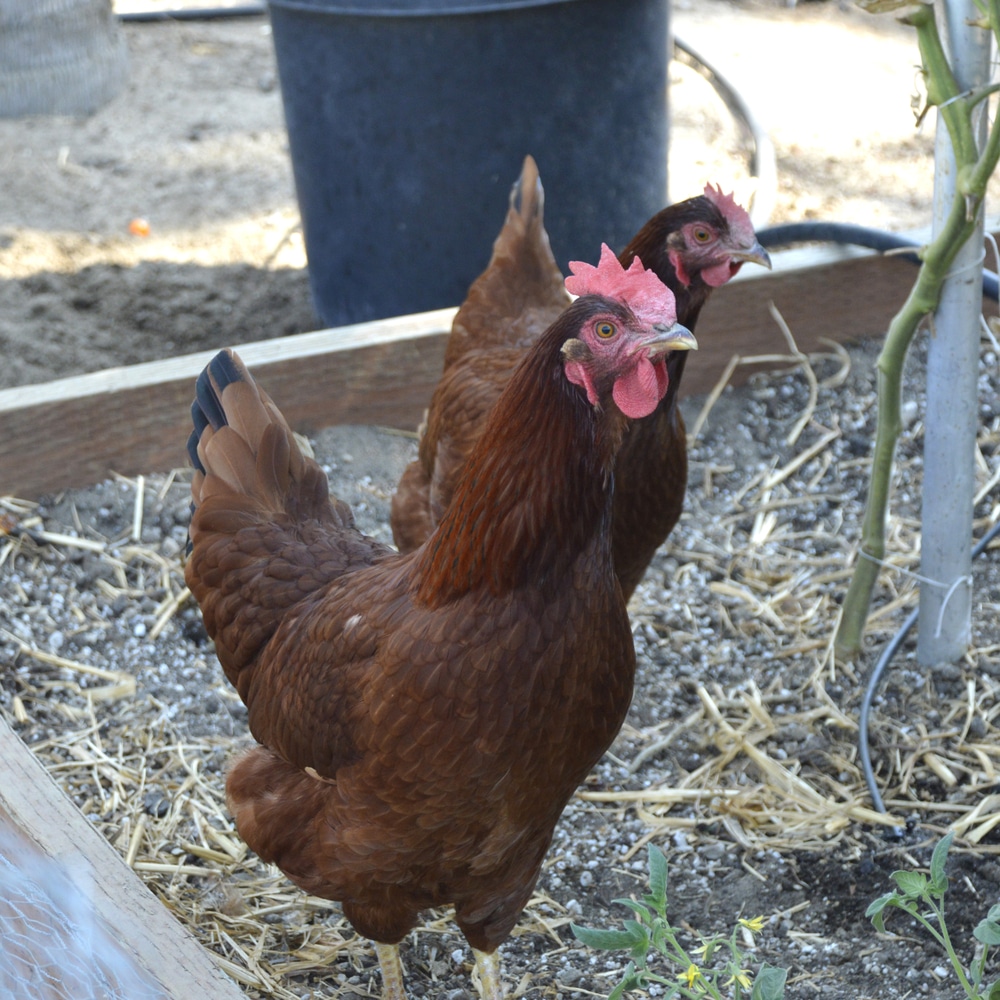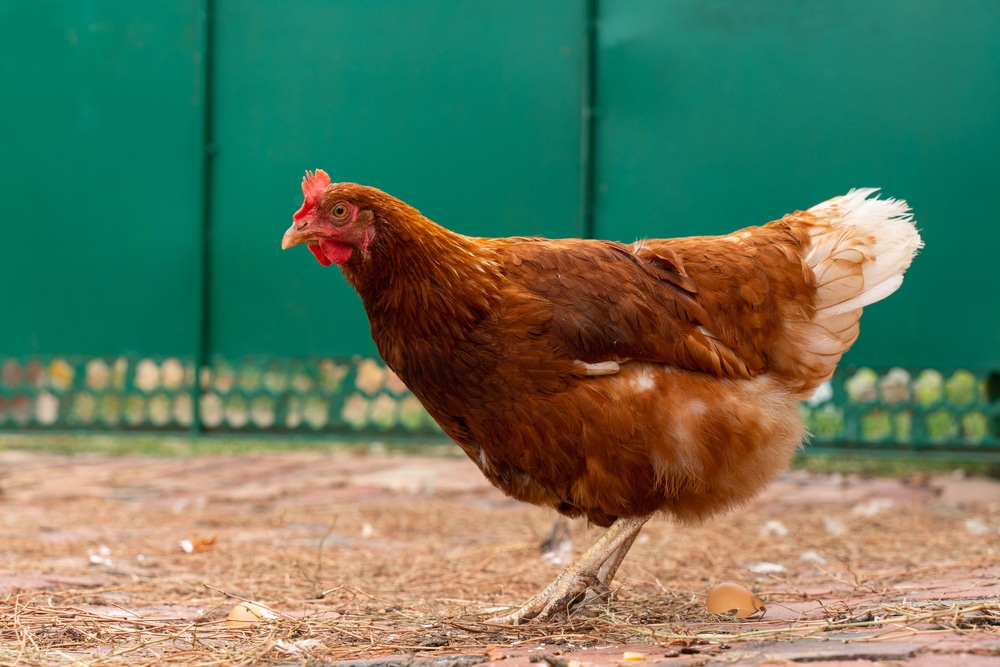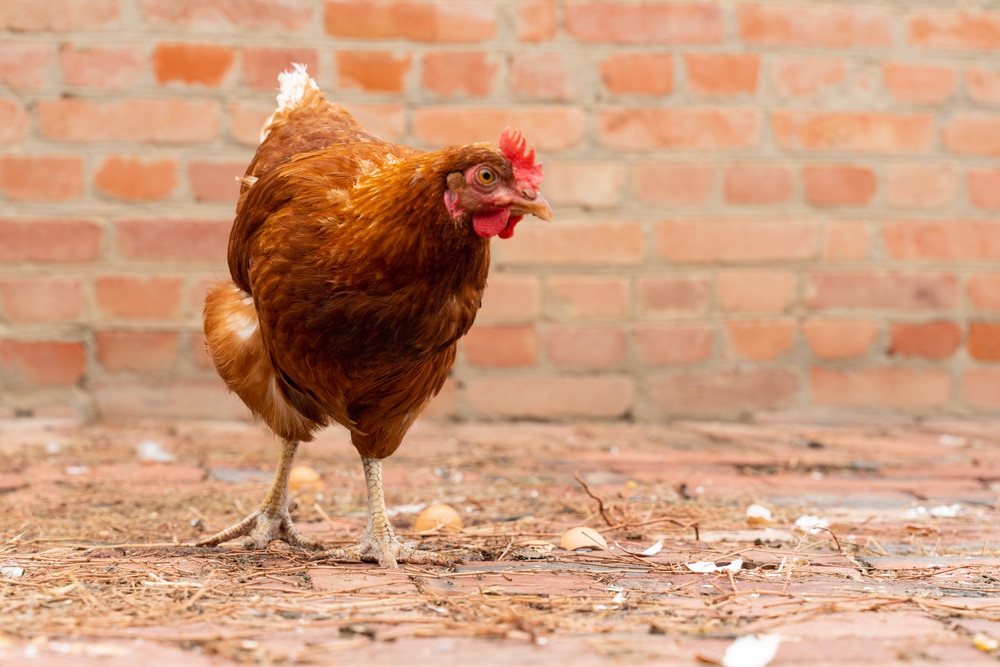Picture a backyard chicken coop.
What comes to mind? What do the chickens look like?
If the image of a stately red chicken with glossy gorgeous feathers comes to mind, you’re not alone.
In fact, if you’ve researched chicken breeds at all, you’ve probably heard your fair share of information about the Rhode Island Red breed.
Native of course, to Rhode Island, this chicken breed is one of the most popular around.
It’s prized for its ability to produce large amounts of both meat and eggs, and it is considered the quintessential chicken breed.
[toc]
History of the Breed

Bred in the late nineteenth century, the Rhode Island Red chicken breed is considered a heritage breed in the United States.
It was developed in Rhode Island for both egg and meat production, but interestingly, over the last few years, much of these meat production genes have been bred out of the birds so that they are now predominantly egg layers.
The Rhode Island Red was accepted by the American Poultry Association in the early 1900s.
It is the result of breeding Malay chickens and brown Leghorn birds from Italy and also spent much of its early days on farms in Massachusetts.
Rhode Island Reds get their color from the Malay chicken, which has a luxurious deep red plumage.
While these are the primary genetic influences in the Rhode Island Red, it is believed that the birds also have some Cochin, Shanghai, and Java genetics, too.
The breed was first named by Isaac Champlin Wilbour.
Unfortunately, traditional Rhode Island Reds are listed as being under “watch” by the Livestock Conservancy.
As more people turn to commercial breeds to fulfill the need for massive quantities of eggs and meat, this bird is becoming increasingly less popular in people’s backyards.
Appearance

The breed standard for the Rhode Island Red was produced in 1898, quickly approved by the American Rhode Island Red Club in Boston in 1901.
While the original Standard of Perfection of the American Poultry Association for the single-comb was accepted in 1904, the rose comb later, in 1906.
Rhode Island Reds are a lustrous deep red to an almost black in color. Their plumage is elegant to behold, as are their tails, which are mostly black.
They can have single or rose combs, but either will be a vivid red. So, too, are the wattles and earlobes.
These chickens have reddish-orange eyes, red-brown beaks,and yellow legs and feet. Occasionally, the chickens will have a bit of red on their shanks and toes. They have yellow skin and no feathering on their legs.
Interestingly, industrial versions of these chickens are sometimes paler in color as well as a smaller size than older heritage varieties.
Modern Rhode Island Reds are almost always heavier in weight and taller in stature than traditional Rhode Islands.
Today, most Rhode Island Red roosters will weigh between 8.5 to 9.5 pounds. Hens are marginally smaller at 6.5 to 7.5 pounds. Birds with more ancient genetics might be later.
If you plan on raising a Rhode Island Red as a dual-purpose breed, make sure you stick with heritage lines. Those that were bred for factory production aren’t quite as beautiful, productive or interactive as traditional breeds.
Temperament & Personality
The Rhode Island Red chicken breed has a reputation for being somewhat aggressive and remarkably territorial -this is especially true among the roosters.
While hens aren’t known for being overly antagonistic, they can be ornery toward each other.

They are usually quite standoffish towards humans, making them not the best choice for pets.
Rhode Island Red hens aren’t known for becoming broody, but if you do have a hen go broody, it could be that she has older genetic sin her blood. This was a trait that has mostly been bred out of the modern lines.
Despite their somewhat cranky demeanors, these chickens are energetic and quite fun to watch.
They aren’t the best choice for people with other pets or children – or chickens of other breeds – but if you plan on raising a flock comprised solely of Rhode Island Reds, you won’t have any problems with their aggressive inclinations.
If you have chickens of other types in your backyard flock, just make sure you select breeds that are aggressive in their own right, too.
When housed with other chicken breeds who aren’t afraid to assert themselves, Rhode Island Reds usually end up in the middle of the pecking order.
These chickens are active birds, spending most of their time foraging for seeds, bugs, and other tasty morsels. They are known for being exceptionally curious, often getting themselves into situations that they shouldn’t as a result!
If you raise Rhode Island Reds, just make sure you have plenty of space for them to forage – where they can be safe doing so.
Just as you should only raise Rhode Island Reds from traditional lines if you are looking for a beautiful, deep red bird with the appropriate breed standards, you should also consider raising a heritage bird if you want to control its behavior.
Birds from traditional lines tend to be less aggressive and more friendly than newer birds, and are less likely to bully other birds, too.
Egg Laying and Meat Production
Although they can make great companions, most people raise chickens for two reasons – eggs or meat.
In this section we will cover Rhode Island Red chicken productivity.
Is the Rhode Island Red Chicken a Good Layer?
Rhode Island Red chickens are commonly raised today for their superb egg production. Just one hen can produce more than 280 eggs each year! Their eggs are large and brown.
Rhode Island Red chickens are known for their eggs, referred to as “egg-laying machines” by McMurray Hatchery. When mature and laying at peak ability, they can give you six eggs each week.
Rhode Island Red chickens will begin laying eggs at around 18 to 20 weeks of age. Some may start early, though, at around sixteen weeks. The eggs are known to increase with size each year.
Rhode Island Reds, like all chicken breeds, sometimes slow their laying during the winter months. This is due to a shortening of daylight hours and can be remedied by hanging a light in the chicken coop.
This will provide the light supplementation they need to be encouraged to lay – adding extra feed can help, too.
Otherwise, feel free to give your girls a break during the winter.
It is good for their reproductive systems and as long as you don’t rely on egg production to remain stable all winter, there is no reason why they need to keep laying.
Is the Rhode Island Red Chicken Good for Meat Production?
This is a question to which there is not a clear answer – while traditional, heritage-breed Rhode Island Reds are known for their decent meat production, birds with newer genetics in them won’t be as good for this purpose.
If you want to raise Rhode Island Red chickens for meat, purchase them from small scale breeders who have been able to preserve the heritage and quality of the breeder.
Birds from older lines have the potential for excellent meat production but they do grow somewhat more slowly than those from newer lines.
Choosing a Rhode Island Red chicken for meat production is possible, though – just keep in mind that the final bird in your roasting pan won’t look quite like the one you are used to! It will have a narrower body but will taste spectacular nonetheless. It will also be a lighter bird with a lower yield of meat overall.
Common Breed-Related Problems
Rhode Island Red chickens are robust birds with very few health issues. They are hardy to most conditions and rarely fall victim to illnesses.
You can improve the health of your birds by maintaining a clean coop, preventing overcrowding, and creating good dust bathing areas.
As with all chicken breeds, mites and similar ectoparasites can pose problems. Keeping an eye on your chickens and maintaining clean conditions, as mentioned, can help.
Since Rhode Island Red chickens are such active layers, they can be prone to certain egg-related issues. You can prevent most of these by providing plenty of calcium in the diet. This will ensure that the hall of their eggs are strong and healthy.
One example of such an issue is egg binding.
This occurs when the egg cannot be passed out of the bird. Another issue is yolk peritonitis.
These health issues frequently come about when commercial birds are sold to backyard producers for extended dallying seasons. Two or three seasons later, it is not uncommon for the birds to develop egg- and reproductive-related issues.
Watch out for issues in egg production, particularly if you are raising Rhode Island Reds from newer lines of breeding stock.
Often these conditions are not resolved except by surgery – yet another reason why it’s important to invest in heritage breeds instead of commercial ones.
Make sure you only introduce healthy chickens to your backyard flock. This is true even if you are raising a flock of only one chicken breed.
Chickens should have access to plenty of healthy food and clean water. You usually won’t need to treat your birds with vaccines and antibiotics at all.
There are some diseases, such as Marek’s, that most baby chicks are vaccinated against before they even leave the hatchery.
Other contagious diseases to watch out for include fowl cholera, avian influenza, fowl pox, coccidiosis, salmonellosis, and Newcastle disease.
While not all of these are deadly – and very few are actually that common in typical backyard chicken coops – they can be prevented by enacting good hygiene and making sure you inspect your chickens on a regular basis.
Environment Requirements
The Rhode Island Red chicken breed can be raised just about anywhere in the country.
The breed is quite adaptable, performing well in a coop as well as when allowed to free-range.
It does best in colder climates, and not in hot weather. These birds are occasionally prone to frostbite, but this is easy to prevent with a dab of petroleum jelly on the comb – it’s not as easy to prevent heat exhaustion in southern climates.
How to Raise a Rhode Island Red Chicken

Caring for a Rhode Island Red chicken is no different than caring for a chicken from any other breed. They are relatively low-maintenance when it comes to feeding, as they are good foragers.
Simply give your chicks a high-quality chick starter for the first few weeks of life. Once they reach sixteen weeks, you can transition them to a laying feed.
Make sure there is extra calcium, too, if this isn’t supplied in a layer pellet – this will help them form strong, healthy eggs.
Rhode Island Reds don’t like to be crowded, so make sure you have adequate housing. Four square feet per bird in the coop is necessary, while you will need at least ten outside.
Designed to handle the extremes of New England winters, this chicken is a hardy bird that requires very little weatherproofing of the coop and run to withstand the cold.
Benefits and Drawbacks of Raising Rhode Island Reds
Here are a few benefits and drawbacks of raising Rhode Island Red Chickens:
Benefits
The Rhode Island Red chicken is one of the best choices for a small flock owner. It is hardy and one of the best egg layers out of all of the dual-purpose breeds.
Rhode Island Red chickens are prized for their ability to thrive on less-than-perfect feed and forage.
You don’t need to supply them with a lot of grain, as they will enjoy foraging for their own food. They also don’t need a lot when it comes to housing.
Rhode Island Red chickens would rather be let out to free-range during the day, and if you are able to provide them with the space to do this, you will likely reap the benefits in higher-quality meat and eggs.
You don’t have to worry about them becoming broody or hiding eggs on you, either.
When they do go broody, however, Rhode Island Reds are known for being excellent mothers and protective guardians of their nests.
They are not known for abandoning unhatched eggs, either.
Plus, Rhode Island Red chickens hold up well to cold environments. Originally developed in the brutal cold of the Northeast, these chickens know how to deal with snow, ice, and chill.
Just keep an eye out for frostbite – because the Rhode Island Red has a single large comb, it is more prone to frostbite.
Rhode Island Red chickens are fantastic foragers. If you are interested in raising free-range chickens, this is one of the best breeds for you to consider.
They will spend most of their days foraging for bugs, frogs, and even mice. Although they can tolerate a level of confinement, they prefer to be let loose on your lawn.
Some people also choose to raise Rhode Island Reds for show purposes. When you’re raising a Rhode Island Red chicken for exhibition, just pay attention to its color.
You want to avoid breeding hens that are a medium-red in color and instead look for those that have darker, deeper hues.
You need to be careful about black feathering anywhere else than in the wings and tails, too. Known as smut, this excess black feathering can disqualify your birds for exhibition.
Drawbacks
One of the biggest challenges of raising Rhode Island Red chickens has to do with their behaviors.
While these chickens are easy to manage if you like to take a more hands-off approach to chicken keeping, it’s important to recognize that the roosters can be quite aggressive.
While hens can occasionally be docile, inquisitive, and downright personable, roosters can be quite mean.
You need to watch out for aggression, particularly if there are kids around, and particularly if you have more than one rooster.
Cockfighting is common in flocks of Rhode Island Reds, and you need to watch about hens picking on smaller members of the flock, too.
Another challenge in raising the Rhode Island Red chicken breed is that they aren’t particularly prepared for hot weather.
While they do well in the cold, they can get overheated quickly in soaring temperatures. Make sure you have decent shelter for the warmest days of summer.
Is the Rhode Island Red Chicken Right for You?
If you’re in the market for one of the world’s best-laying hens, look no further than the Rhode Island Red chicken.
This breed is a no-frills and no-fuss breed, with each chicken sporting its own unique personality and enthusiasm.
Rhode Island Red chickens aren’t necessarily the best breed for people new to raising chickens – although they can thrive on sub-par feed and housing conditions, it can be tough to familiarize yourself with the ins- and outs-of chicken keeping if you have such a low-maintenance breed.
This could pose problems later on when you introduce other breeds and aren’t used to the demands!
Plus, Rhode Island Reds can be a bit aggressive, something to avoid if you’re new to raising chickens.
Otherwise, the Rhode Island Red is an excellent choice for most backyard chicken keepers. If you’re looking for a fantastic egg layer and a beautiful addition to your flock to boot, look no further than this illustrious breed.
